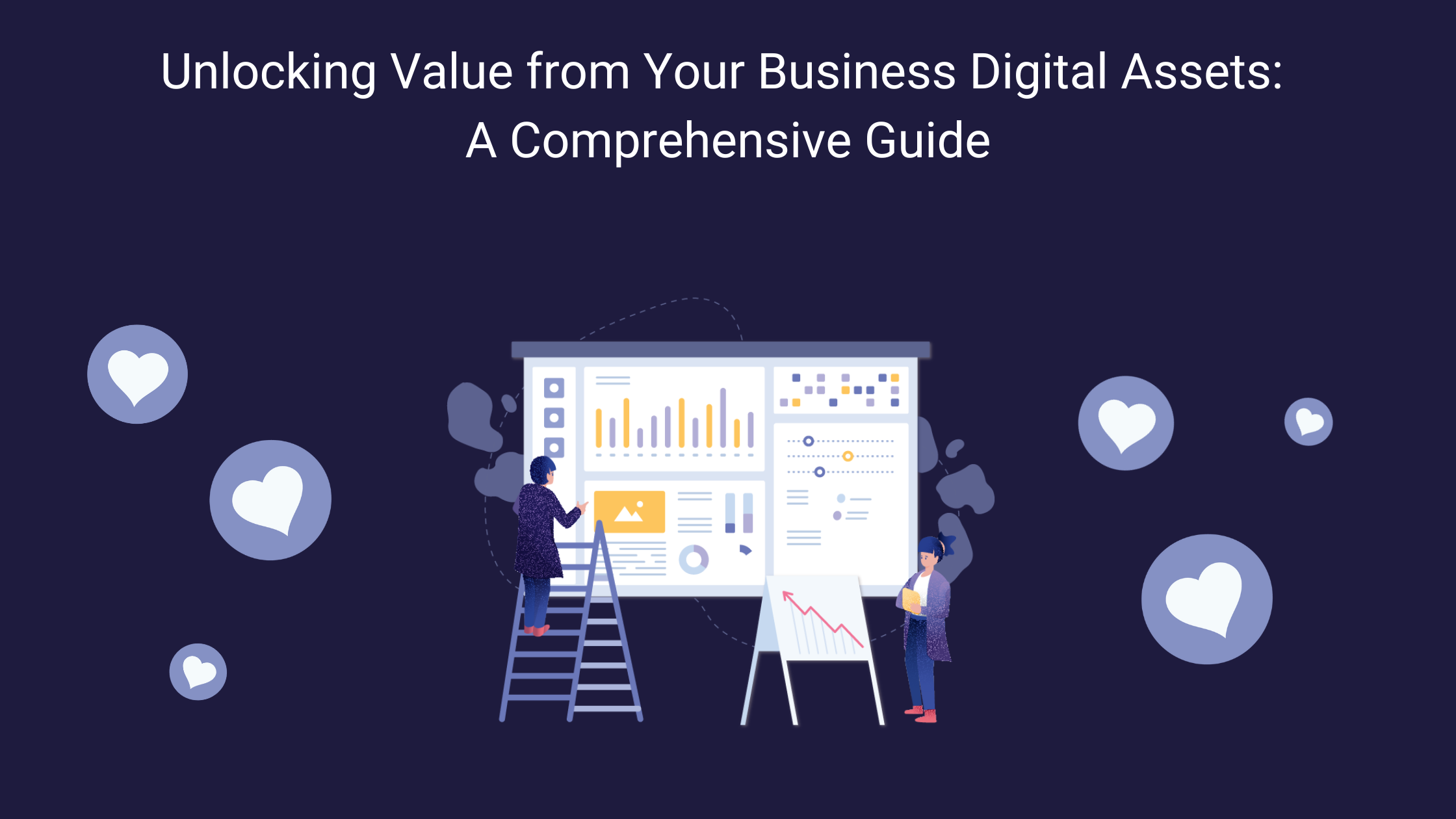In the rapid-fire world we live today, the digital landscape has transformed how businesses operate, communicate, and even value their resources. In the epicenter of this transformation lies an enterprise’s most valuable but often underappreciated resource – the Digital Assets. From that essential customer email list to your robust social media profile, digital assets are propelling businesses towards unparalleled heights of success.
This blog post is created as a comprehensive guide to understanding, managing, and maximizing the value of your business’s digital assets. So whether you’re an established business looking to optimize your digital resources, or a budding entrepreneur trying to grasp the basics, buckle up. We’re about to embark on an enlightening journey through the transformative world of business digital assets. Let’s illuminate the hidden opportunities beneath the binary codes.
Table of Contents
What are business digital assets?
Business digital assets is a term that encapsulates various forms of online and digital resources owned and controlled by a business. These assets are more often than not essential in today’s digital-driven world, playing a critical role in developing and maintaining a company’s competitive edge.
They come in a wide array of forms:
Websites and Blogs: These are crucial touchpoints for companies to engage and communicate with their customers. They often serve as the central hub for a company’s online presence.
Social Media Accounts: Your handles on platforms like Instagram, Twitter, LinkedIn, or Facebook are key to your online identity. They allow direct interaction with your audience and can be instrumental in driving traffic to your website or product pages.
Email Lists: These are lists of customers or prospects who have opted to receive marketing materials or communication from your business. They are incredibly valuable for direct marketing campaigns.
Content: This includes all digital content owned by your business, whether it’s blogs, articles, infographics, videos, or podcasts.
Software and Applications: Any software or applications developed by your company, including mobile apps, are valuable digital assets that bolster your brand’s identity.
Digital Intellectual Property: This includes trademarks, patents, and any proprietary processes or ideas in digital form.
Data and Analytics: This includes customer data, market research data, and any data-driven insights that may inform business strategies.
Understanding these digital assets is the first step to leveraging them effectively for your business’s growth and longevity.
Why do businesses need digital assets?
In this increasingly digital age, businesses cannot afford to overlook the value of digital assets. These resources serve several vital functions that directly contribute to a company’s growth, reputation, and competitive standing. Here’s why businesses need digital assets:
Boost Visibility and Reach: In a world where virtually everyone is online, digital assets like websites and social media profiles increase a business’s visibility to potential customers globally. Your digital presence has the potential to extend beyond physical boundaries, drawing in a much broader audience.
Build Brand Identity and Reputation: Digital assets like blogs, articles, videos, and infographics help communicate your brand’s personality, values, and message to the audience. They help to establish a distinctive identity and build a strong reputation in the market.
Engage and Communicate with Customers: Digital assets offer the opportunity to interact with customers. This could be via social media platforms or email marketing, providing real-time service and building stronger relationships.
Drive Sales and Revenue: Websites, and particularly e-commerce platforms, are direct revenue-generating tools. Additionally, assets like email lists and customer data help in creating personalized marketing campaigns to promote products or services, driving sales.
Inform Business Strategy: Data is a powerful digital asset that provides valuable insights into customer behavior, market trends, and business performance. This information can shape strategic decisions and fuel growth.
Secure Competitive Advantage: Digital assets like proprietary software or patented processes give businesses an edge over competitors. They provide unique offerings that others can’t replicate easily.
How can businesses start to build their digital assets?
Building digital assets is a strategic process that demands time, effort, and a thorough understanding of your business objectives. Here’s a step-by-step guide to start building your business’s digital assets:
Identify Your Needs: The first step in the process is to determine what digital assets your business needs. Does your business need a robust website or a mobile app? Would your audience respond well to a series of instructional videos or a regular blog? The answers will depend on your industry, target market, and overall business goals.
Create Your Digital Assets: After determining your needs, you’ll need to start creating your assets. This might involve hiring a web designer to create a website or contracting a content writer to build up your blog. Remember to always prioritize quality – your digital assets represent your business in the online world!
Secure Your Assets: Safety is paramount in the digital realm. Ensure that your website is secure, your data is backed up, and your digital intellectual properties are legally protected. Digital asset management systems can be used to store, organize, and secure your digital assets.
Grow and Maintain Your Assets: Just like any other asset, digital assets need to be nurtured and maintained. You need to keep your website updated, post on social media consistently, continually add to your blog, and refresh your email list.
Monitor and Review: Lastly, use analytic tools to monitor the performance of your digital assets. How much traffic is your website getting? How many leads are being generated from your email list? These insights will help you determine the return on investment of your digital assets and inform future strategies.
Remember, crafting a strong portfolio of digital assets won’t happen overnight. But with patience, persistence, and the right approach, your business can harness the power of digital assets to drive growth and success.
Managing your digital assets
Managing digital assets can be an intricate, yet crucial, part of a business’s operation. It involves organizing, storing, securing, and properly utilizing these resources to maximize their potential. Here’s a guide to proficiently managing your business’s digital assets:
Implement a Digital Asset Management (DAM) System: A DAM system is a centralized platform where you can store, catalogue, and access your digital assets. It simplifies the searching, sharing, distributing, and repurposing of assets, thus increasing efficiency and productivity.
Create Clear Organizational Structures: Categorize and tag your assets for easy identification and retrieval. A well-structured, intuitive system will save time and reduce frustration when trying to locate specific assets.
Secure Your Assets: Implement stringent security measures to protect your digital assets from cyber threats. Regularly back up data, use encryption, restrict access, and ensure all software is regularly updated to guard against potential breaches.
Establish Usage Guidelines: Create a clear policy about how each digital asset should be used, including branding guidelines, copyright restrictions, and sharing protocols. This ensures consistency in brand representation and legal compliance.
Regular Audits: Regularly review your digital assets to remove redundant or outdated items and identify gaps that need to be filled. This keeps your digital assets fresh and relevant.
Monitor Performance: Use analytics to track how your digital assets are performing. Understanding which assets are driving traffic, generating leads, or contributing to conversions can help you optimize and prioritize your resources.
Train Your Team: Ensure your team is knowledgeable about how to use the DAM system and understands the importance of keeping digital assets organized and secure.
FAQs
A digital asset refers to any uniquely identifiable resource, stored in a digital form, that businesses can leverage to generate value. This broad spectrum encompasses an array of resources such as written documents, auditory files, video content, corporate logos, slide decks, data-filled spreadsheets, and even entire websites.
Digital assets can take on various forms, ranging widely from written documents, sound recordings, video clips, brand logos, PowerPoint presentations, data-driven spreadsheets to comprehensive websites.
Managing a business's digital assets involves implementing a robust Digital Asset Management (DAM) system for storage and retrieval, coupled with clear organizational structures, strategic security measures, usage guidelines, regular audits, and team training. It's a thorough process aimed to maximize efficiency, safeguard resources, and enhance business productivity in the digital landscape.
Conclusion
In conclusion, navigating the digital landscape of business today mandates a deep understanding, strategic building, and careful management of digital assets. From shaping your online identity to driving sales, these digital resources are the lifeblood of your business’s online presence and success.
By realizing the potential that lies within these digital assets and harnessing it effectively, businesses can elevate their operational efficiency, boost their competitive edge, and foster significant growth in our increasingly digital world.
So, get started on this journey today – assess, build, and manage your digital assets strategically – because the future of business is undeniably digital!





